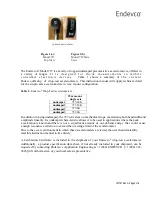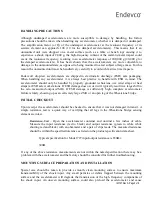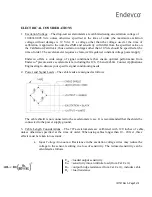
IM727 Rev A, Page 3 of 9
®
HANDLING PRECAUTIONS
Although undamped accelerometers are more susceptible to damage by handling, the follow
precautions should be taken when handling any accelerometer, whether it is damped or undamped.
The amplification factor (or Q) of the undamped accelerometer at the resonant frequency of its
seismic element can approach 100 (10 for the damped accelerometers). This means that if an
unmounted unit were dropped on a metal surface (such as a table or bench top) causing it to
experience a shock input of 2,000 g, the high-frequency content of the metal-to-metal impact could
excite the resonance frequency, resulting in an accelerometer response of 200,000 g (20,000 g for
the damped accelerometers). It has been shown that the accelerometers are more vulnerable to
damage in the unmounted state, as opposed to being mounted to a test subject of large mass. For this
reason the unmounted unit must be handled very carefully to avoid such fast rise time impacts.
Endevco® drop-test accelerometers are shipped in electrostatic discharge (ESD) safe packaging.
When handling any accelerometer it is always best practice to handle with ESD in mind. The
accelerometer should only be handled by properly grounded technicians (via wrist straps or heel
straps) at ESD safe work stations. If ESD damage does occur it will typically result in a large shift in
the zero measurand output (ZMO). If ESD damage is sufficiently high, complete accelerometer
failure is likely, showing up as an extremely large ZMO or an open leg of the Wheatstone bridge.
INITIAL CHECKOUT
Upon receipt, the accelerometer should be checked to ensure that it was not damaged in transit. A
simple resistance test is a quick way of verifying that all legs in the Wheatstone bridge sensing
element are intact.
Resistance Test – Open the accelerometer container and unwind a few inches of cable.
Measure the input resistance (red to black) and output resistance (green to white while
shorting red and black) with an ohmmeter and a pair of clips leads. The measured resistance
should be within the specified tolerance as listed on the product specification data sheet.
Typical specification for Model 727 input/output resistance is 650Ω ±
300Ω
If any of the above resistance measurements are not within the noted specification there may be a
problem with the accelerometer and the factory should be consulted for further troubleshooting.
MOUNTING SURFACE PREPARATION AND INSTALLATION
Special care should be taken to provide a smooth, clean mounting surface to ensure maximum
transmissibility of the shock input. Any small particles or debris trapped between the mounting
surface and the accelerometer will degrade the transmission of the high- frequency components of
the shock input. An uneven mounting surface could also preload the accelerometer and cause









